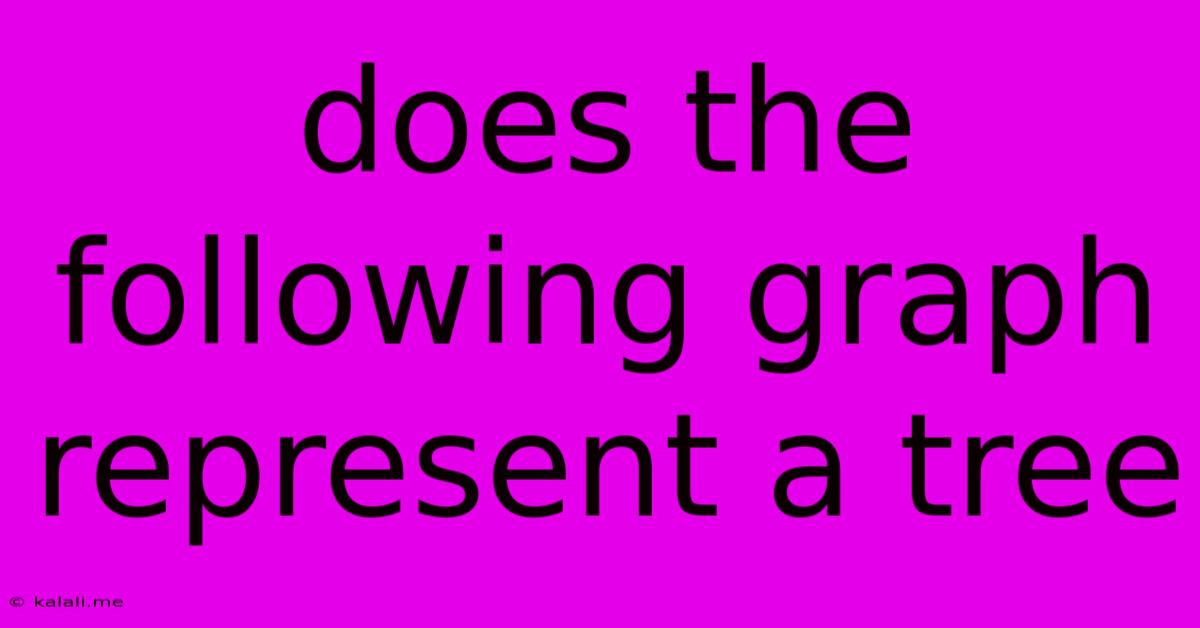Does The Following Graph Represent A Tree
Kalali
Jun 15, 2025 · 3 min read

Table of Contents
Does the Following Graph Represent a Tree? A Comprehensive Guide
Determining whether a given graph represents a tree involves understanding the fundamental properties of trees in graph theory. This article will explore these properties and provide a step-by-step method to analyze any graph and definitively answer the question: "Is this a tree?" Understanding this is crucial for various applications in computer science, data structures, and network analysis.
What is a Tree in Graph Theory?
A tree, in the context of graph theory, is an undirected graph that satisfies two key properties:
-
Connectivity: Every pair of vertices (nodes) in the graph is connected by exactly one simple path. This means you can reach any node from any other node by following edges without retracing your steps.
-
Acyclicity: The graph contains no cycles. A cycle is a path that starts and ends at the same vertex, visiting other vertices in between without repeating any edges.
How to Determine if a Graph is a Tree
There are several methods to check if a graph is a tree. Here's a breakdown of the most common approaches:
1. Visual Inspection (for small graphs):
For smaller graphs, a visual inspection can often suffice. Carefully examine the graph to see if it meets the two criteria defined above:
- Connectivity: Can you reach every node from every other node through a unique path?
- Acyclicity: Are there any closed loops or cycles in the graph?
If both conditions are true, the graph is a tree. However, this method becomes impractical for larger, more complex graphs.
2. Using the Number of Edges and Vertices (for any graph):
A more robust and mathematically sound method uses the relationship between the number of vertices (V) and the number of edges (E) in the graph. For a connected graph to be a tree, the following condition must hold:
E = V - 1
If this equation is true, and the graph is connected, then it's a tree. If the equation is false, it's not a tree. Note that this method only works if the graph is already known to be connected. You might need to perform a connectivity check first (using Depth-First Search or Breadth-First Search algorithms, for example).
3. Depth-First Search (DFS) or Breadth-First Search (BFS):
DFS and BFS are graph traversal algorithms. They can be used to verify both connectivity and acyclicity.
- Connectivity: If a DFS or BFS starting from any arbitrary node visits all nodes in the graph, the graph is connected.
- Acyclicity: During DFS, if you encounter a node that has already been visited (other than the starting node of the current path), you've detected a cycle. Similarly in BFS, if you encounter an already visited node not following the parent-child relation from the root node.
If both connectivity and acyclicity are verified, the graph represents a tree. This approach is suitable for larger graphs where visual inspection isn't feasible.
Example:
Let's say we have a graph with 5 vertices (V=5) and 4 edges (E=4). Since E = V - 1 (4 = 5 - 1), it could be a tree. However, we need to verify connectivity. If a visual inspection or DFS/BFS shows the graph is connected, then it is indeed a tree. If the graph is not connected, it’s not a tree, despite satisfying the E = V - 1 condition.
Conclusion:
Determining if a graph is a tree involves checking for connectivity and acyclicity. While visual inspection works for small graphs, algorithms like DFS/BFS or the V-E relationship provide more robust methods for larger and more complex graphs. By applying these techniques, you can confidently analyze any graph and determine if it conforms to the definition of a tree. Remember to always check connectivity in addition to the edge-vertex relationship to avoid false positives.
Latest Posts
Latest Posts
-
How Many Main Colours Are There
Jun 15, 2025
-
The Perimeter Of A Rectangle Is 30 Cm
Jun 15, 2025
-
What Is The Lcm Of 14 And 24
Jun 15, 2025
-
The San Andreas Fault Is An Example Of A
Jun 15, 2025
-
Is A Snake A Tertiary Consumer
Jun 15, 2025
Related Post
Thank you for visiting our website which covers about Does The Following Graph Represent A Tree . We hope the information provided has been useful to you. Feel free to contact us if you have any questions or need further assistance. See you next time and don't miss to bookmark.